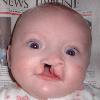

Cleft lip (cheiloschisis) and cleft palate (palatoschisis), which can also occur together as cleft lip and palate, are variations of a type of clefting congenital deformity caused by abnormal facial development during gestation. A cleft is a fissure or opening?a gap. It is the non-fusion of the bodys natural structures that form before birth. Approximately 1 in 700 children born have a cleft lip and/or a cleft palate. It has sometimes colloquially been equated with the phrase harelip, but this is considered deeply offensive, and is used incorrectly, as that term refers to the pulling of the lip towards the nose.
Clefts can also affect other parts of the face, such as the eyes, ears, nose, cheeks, and forehead. In 1976, Paul Tessier described fifteen lines of cleft. Most of these craniofacial clefts are even more rare and are frequently described as Tessier clefts using the numerical locator devised by Tessier.
A cleft lip or palate can be successfully treated with surgery, especially so if conducted soon after birth or in early childhood.
Diseasesdb: 29604
Diseasesdb Mult: DiseasesDB229414
Icd10: ICD10Q35q35-ICD10Q37q35
Icd9: ICD9749
Emedicinesubj: ped
Emedicinetopic: 2679
Meshid: Wiktionarycleft lip

